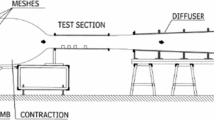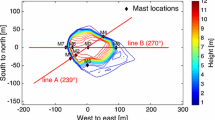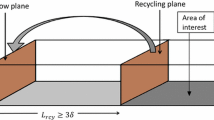Abstract
Simulation of local atmospheric flows around complex topography is important for several applications in wind energy (short-term wind forecasting and turbine siting and control), local weather prediction in mountainous regions and avalanche risk assessment. However, atmospheric simulation around steep mountain topography remains challenging, and a number of different approaches are used to represent such topography in numerical models. The immersed boundary method (IBM) is particularly well-suited for efficient and numerically stable simulation of flow around steep terrain. It uses a homogenous grid and permits a fast meshing of the topography. Here, we use the IBM in conjunction with a large-eddy simulation (LES) and test it against two unique datasets. In the first comparison, the LES is used to reproduce experimental results from a wind-tunnel study of a smooth three-dimensional hill. In the second comparison, we simulate the wind field around the Bolund Hill, Denmark, and make direct comparisons with field measurements. Both cases show good agreement between the simulation results and the experimental data, with the largest disagreement observed near the surface. The source of error is investigated by performing additional simulations with a variety of spatial resolutions and surface roughness properties.













Similar content being viewed by others
References
Albertson JD, Parlange MB (1999) Surface length scales and shear stress: implications for land–atmosphere interaction over complex terrain. Water Resour Res 35(7):2121–2132
Allen T, Brown AR (2002) Large-eddy simulation of turbulent separated flow over rough hills. Boundary-Layer Meteorol 102(2):177–198
Andren A, Brown AR, Graf J, Mason PJ, Moeng CH, Nieuwstadt FTM, Schumann U (1994) Large-eddy simulation of a neutrally stratified boundary-layer—a comparison of 4 computer codes. Q J R Meteorol Soc 120(520):1457–1484
Balaras E (2004) Modeling complex boundaries using an external force field on fixed Cartesian grids in large-eddy simulations. Comput Fluids 33(3):375–404
Bechmann A, Berg J, Courtney MS, Jørgensen HE, Mann J, Sørensen NN (2009) The Bolund experiment: overview and background. Technical report, Riso DTU, National Laboratory for Sustainable Energy, Denmark
Bechmann A, Sorensen NN, Berg J, Mann J, Rethore PE (2011) The Bolund experiment, Part II: blind comparison of microscale flow models RID C-6255-2011 RID C-5528-2011. Boundary-Layer Meteorol 141(2):245–271
Berg J, Mann J, Bechmann A, Courtney MS, Jorgensen HE (2011) The Bolund experiment, Part I: flow over a steep, three-dimensional Hill RID C-6255-2011. Boundary-Layer Meteorol 141(2):219–243
Bou-Zeid E, Meneveau C, Parlange MB (2004) Large-eddy simulation of neutral atmospheric boundary layer flow over heterogeneous surfaces: blending height and effective surface roughness RID A-9796-2008 RID A-3319-2010. Water Resour Res 40(2):W02505
Bou-Zeid E, Meneveau C, Parlange M (2005) A scale-dependent Lagrangian dynamic model for large eddy simulation of complex turbulent flows RID A-9796-2008 RID A-3319-2010. Phys Fluids 17(2):025105
Brown AR, Hobson JM, Wood N (2001) Large-eddy simulation of neutral turbulent flow over rough sinusoidal ridges. Boundary-Layer Meteorol 98(3):411–441
Cal RB, Lebron J, Castillo L, Kang HS, Meneveau C (2010) Experimental study of the horizontally averaged flow structure in a model wind-turbine array boundary layer. J Renew Sust Energy 2(1):013106
Calaf M, Meneveau C, Meyers J (2010) Large eddy simulation study of fully developed wind-turbine array boundary layers. Phys Fluids 22(1):015110
Chester S, Meneveau C, Parlange MB (2007) Modeling turbulent flow over fractal trees with renormalized numerical simulation. J Comput Phys 225(1):427–448
Chow FK, Street RL (2009) Evaluation of turbulence closure models for large-eddy simulation over complex terrain: flow over Askervein Hill. J Appl Meteorol Clim 48(5):1050–1065
Cristallo A, Verzicco R (2006) Combined immersed boundary/large-eddy-simulations of incompressible three dimensional complex flows. Flow Turbul Combust 77(1–4):3–26
Deardorff JW (1970) A numerical study of 3 dimensional turbulent channel flow at large Reynolds numbers. J Fluid Mech 41:453
Fang JN, Diebold M, Higgins C, Parlange MB (2011) Towards oscillation-free implementation of the immersed boundary method with spectral-like methods. J Comput Phys 230(22):8179–8191
Ferziger J, Péric M (1999) Computational methods for fluid dynamics. Springer, Berlin 426 pp
Gal-Chen T, Somerville RCJ (1975) Numerical-solution of Navier–Stokes equations with topography. J Comput Phys 17(3):276–310
Germano M, Piomelli U, Moin P, Cabot WH (1991) A dynamic subgrid-scale eddy viscosity model. Phys Fluids A 3(7):1760–1765
Ishihara T, Hibi K, Oikawa S (1999) A wind tunnel study of turbulent flow over a three-dimensional steep hill. J Wind Eng Ind Aerodyn 83:95–107
Lilly DK (1967) The representation of small-scale turbulence in numerical simulation experiments. In: The IBM scientific computing symposium on environmental sciences
Lopes AS, Palma JMLM, Castro FA (2007) Simulation of the askervein flow. Part 2: large-eddy simulations. Boundary-Layer Meteorol 125(1):85–108
Loureiro JBR, Monteiro AS, Pinho FT, Freire AP (2009) The effect of roughness on separating flow over two-dimensional hills. Exp Fluids 46(4):577–596
Meneveau C, Katz J (2000) Scale-invariance and turbulence models for large-eddy simulation. Annu Rev Fluid Mech 32:1–32
Mittal R, Iaccarino G (2005) Immersed boundary methods. Annu Rev Fluid Mech 37:239–261
Nieuwstadt F, Mason P, Moeng C, Schumann U (1991) Large-eddy simulation of the convective boundary layer: a comparison of four computer codes. In: 8th symposium on turbulent shear flows
Peskin CS (1972) Flow patterns around heart valves—numerical method. J Comput Phys 10(2):252–271
Peskin CS (2002) The immersed boundary method. Acta Numer 11:1–39
Porte-Agel F, Meneveau C, Parlange MB (2000) A scale-dependent dynamic model for large-eddy simulation: application to a neutral atmospheric boundary layer. J Fluid Mech 415:261–284
Saad Y (1981) Krylov subspace methods for solving large unsymmetric linear-systems. Math Comput 37(155):105–126
Smagorinsky J (1963) General circulation experiments with the primitive equations: I. The basic experiment. Mon Weather Rev 91:99–164
Tamura T, Cao S, Okuno A (2007) LES study of turbulent boundary layer over a smooth and a rough 2D hill model. Flow Turbul Combust 79(4):405–432
Taylor PA, Teunissen HW (1987) The Askervein Hill project—overview and background data. Boundary-Layer Meteorol 39(1–2):15–39
Tseng YH, Ferziger JH (2003) A ghost-cell immersed boundary method for flow in complex geometry. J Comput Phys 192(2):593–623
Tseng YH, Meneveau C, Parlange MB (2006) Modeling flow around bluff bodies and predicting urban dispersion using large eddy simulation. Environ Sci Technol 40(8):2653–2662
Voller VR, Porte-Agel F (2002) Moore’s law and numerical modeling. J Comput Phys 179(2):698–703
Yue WS, Parlange MB, Meneveau C, Zhu WH, van Hout R, Katz J (2007) Large-eddy simulation of plant canopy flows using plant-scale representation. Boundary-Layer Meteorol 124(2):183–203
Acknowledgments
We would like to thank the collaborators who participated in the Bolund Experiment and provided us with the data for comparison. We are also grateful to the Swiss National Supercomputing Centre (CSCS) for the use of their computers. We would like to thank the Swiss National Science Foundation for their financial support under grant 200021-120238. Mary Parlange provided great assistance with english ameliorations. Finally, we thank the reviewers for their valuable suggestions in improving this article.
Author information
Authors and Affiliations
Corresponding author
Rights and permissions
About this article
Cite this article
Diebold, M., Higgins, C., Fang, J. et al. Flow over Hills: A Large-Eddy Simulation of the Bolund Case. Boundary-Layer Meteorol 148, 177–194 (2013). https://doi.org/10.1007/s10546-013-9807-0
Received:
Accepted:
Published:
Issue Date:
DOI: https://doi.org/10.1007/s10546-013-9807-0




